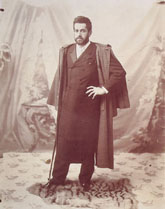 Fortuny Palace Museum - Campo San Beneto, San Marco, 3958 - Venice Fortuny Palace Museum - Campo San Beneto, San Marco, 3958 - Venice
The Civic Museum of Palazzo Fortuny is housed in the homonymous palace that is located inside the San Marco district in a part of a poor tourist passage overlooking Campo San Beneto. It houses the collections that belonged to Mariano Fortuny who was an artist involved in painting, sculpture, lighting, theater, photography, textiles and fashion. The Museum is part of the circuit of the Venetian Civic Museums and organizes art exhibitions especially for spring and autumn.

"Mariano Fortuny was a great modern artist whose inventions ranged from theatrical lighting systems to particular methods for dyeing and printing tessiil.To know his works in the Palazzo Fortuny collections allowed me to draw parallels with my own research Questions related to light, form, matter, structure, seriality and decorative arts are, in fact, at the center of my care.I imagine this exhibition as an opportunity to create a dialogue between works of art, through time, with the spirit and the work of Fortuny ", so Henri Foucault interprets and explains his presence at Fortuny.
The works on display at the Fortuny Museum include two different sets of photographic compositions, Sosein and Satori, centered on the different themes of the corporeity, punctured or redefined by a dense layer of steel pins overlapping them. The work is on the perception of light, on the redefinition of the sense of volume, on the relationship between two-dimensional and three-dimensional, between form and structure, and on the relationship between sculpture and photography. Sosein and Satori, the two series presented here, are therefore the temporary landing of this meeting and the radical overcoming of the traditional artistic categories, such as: space and form, and insist on the seriality of the representation, here exalted through the tension between volume and lightning of the photographic act, between superficiality and three-dimensionality, between illusion and reality.
Palazzo Fortuny also houses some works of art inherited from Mariano's father, Mariano Fortuny Marsal, one of the most influential painters in Spain in the nineteenth century.
History
The Palace was built at the behest of Benedetto Pesaro from the mid-fifteenth century in Gothic style. The realization was so perfect that it was often cited among the best examples of Venetian Gothic.
Residence of a branch of the Pesaro family in Venice Palazzo Fortuny knew its political and social fortunes as on the occasion of the feast given by Pietro Pesaro in 1522 for his election as procurator of S. Marco or on the occasion of the many parties organized by the Compagnia della Calza called the Immortals and the one called the Ortolani for the arrival in the city of princes, patricians and ambassadors (Diarii di Sanudo).
Inside the Pesaro guarded you, exposed for the joy of their important guests, remarkable works of art including a painting by Giorgione. The palace therefore assumed a role of representation that was also mentioned by Francesco Sansovino in his Venetia Citt� Nobilissima in the 16th century, when the Pesaro gave the Serenissima also a Doge.
With the extinction of the Pesaro of Campo San Beneto, the palace passed into inheritance to the other branches of the Pesaro family residing in other sestieri of the city from which the rent was decided; it hosted the Tipografia Albrizzi, the Accademia degli Orfei from 1786, the Apolinnea Society.
In the nineteenth century Palazzo Fortuny hosted small families of modest conditions going towards internal structural changes that divided the original sumptuous space. This was until the artist Mariano Fortuny Madrazo in 1898 decided to rent a large space to use it as his own studio. Understanding the potential of the place Mariano Fortuny bought all the spaces that were slowly freeing up by carrying out renovations to give the original structure to the spaces. After installing his studio he lived there with his partner Henriette until 1949, the year of his death.
Fortuny's testament established that the Palace should go to the City of Venice (1956) so that it would be "used perpetually as a center of culture in relation to art". His will was respected only after the death of his partner Henriette with the opening of the Fortuny Museum in 1975.
Architecture
Palazzo Fortuny is a majestic example of Venetian Gothic characterized by the rare presence of two central arches with acute arches in the two floors of the fa�ade that stands above Campo San Beneto. The balconies bear friezes of lions and cherubs. The interior, in its original structure, however, completely recovered in the twentieth century, is equally impressive having two halls that separate the two facades of the building more than 43 meters long.

How to reach Palazzo Fortuny Museum
The Museum of Palazzo Fortuny is located in Campo San Beneto in San Marco not far from the Grand Canal and can be reached in 5 minutes on foot both from Rialto and San Marco.
From Piazza San Marco, from Rialto, from the train station and from Piazzale Roma, take line 1 with Sant'Angelo stop.
Watch the Video by Venice Civic Museums of
Fortuny Palace Museum
|